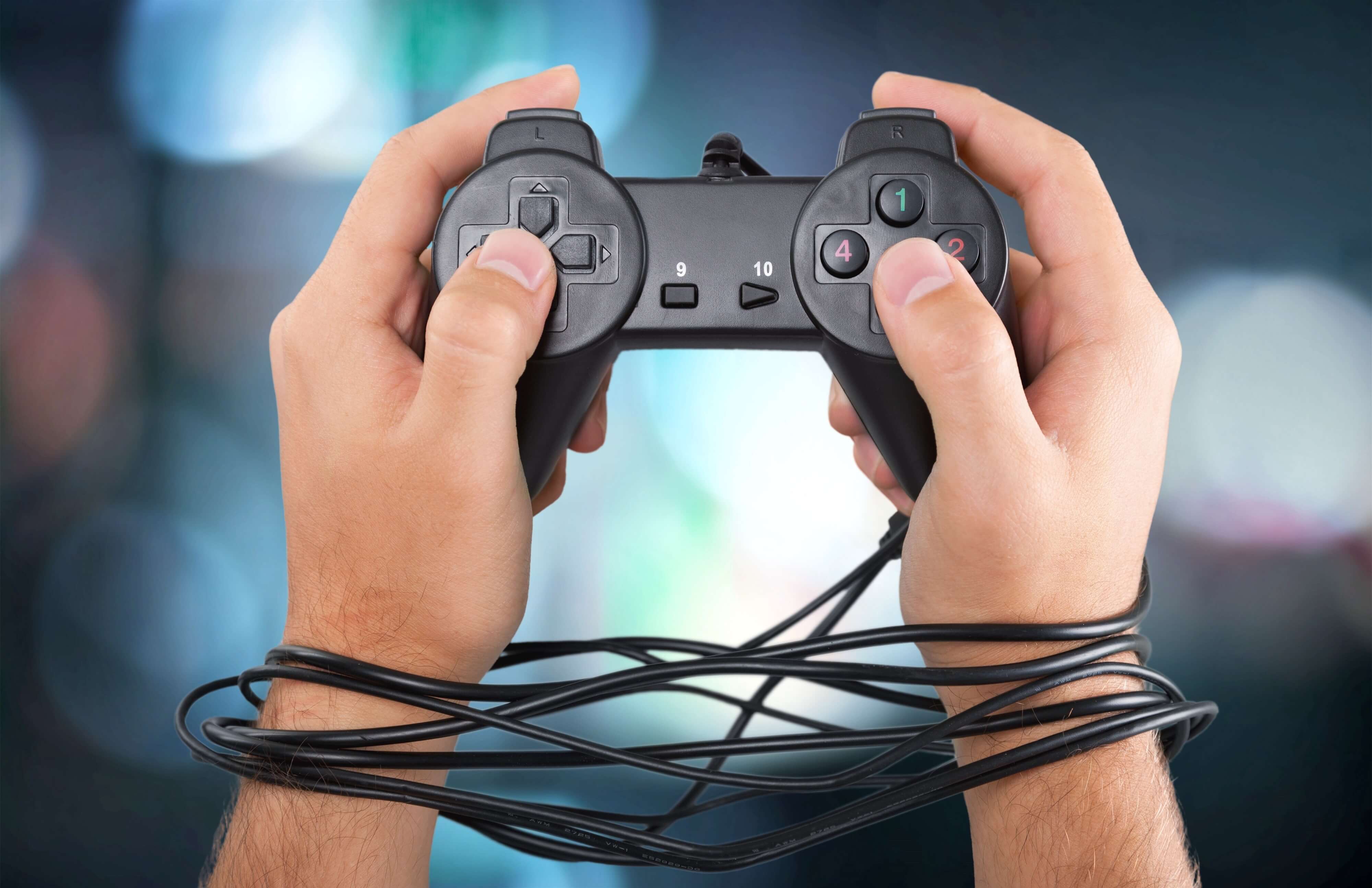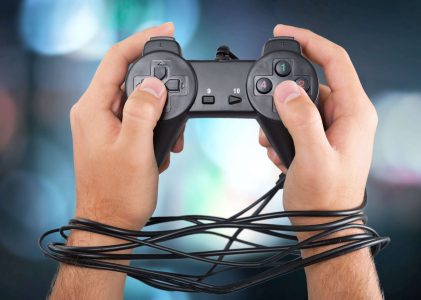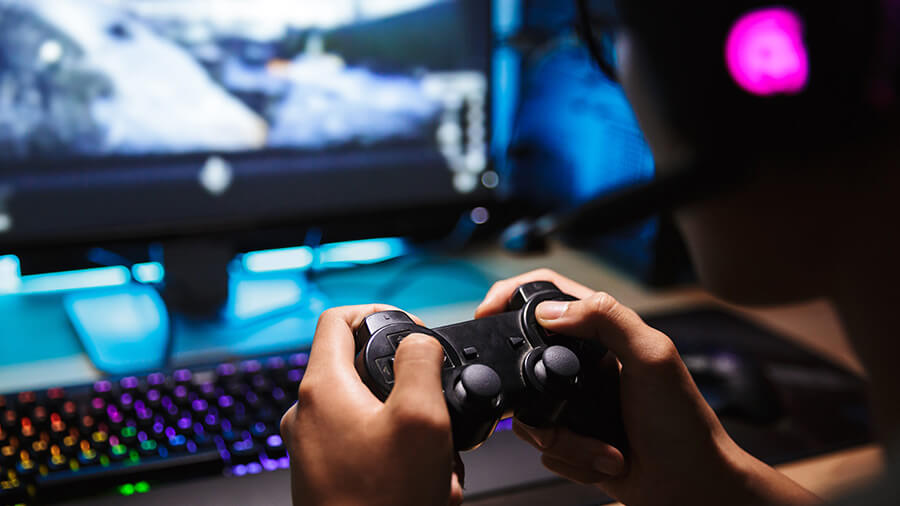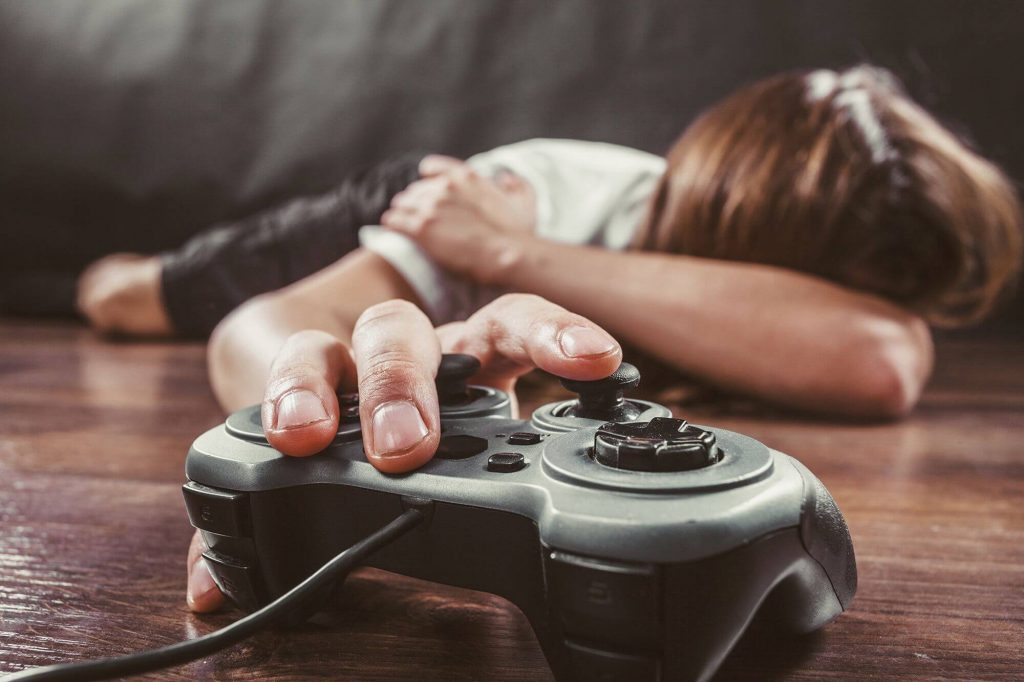Internet gambling disorder – it’s particularly the loss of control over the participation in the computer games. It is expressing in that the player starts to feel obsessive pathological desire to play whatever it takes and against all odds, all the time involving the game, despite the negative consequences in the private life, family, professional, educational and in other important spheres.
Then this attraction (craving) to participate in the game becomes difficult to overcome, despite repeated attempts to stop or reduce the time of the game and as a result, goes into the dominant need, replacing all other interests, activities and relationships with people, and often even the basic needs of the body (sleep, eat, etc.). This leads to significant mental and physical health problems for the player or others.
Often people continue to play all over the day, not even paying attention on the pain. There are cases when as a result of prolonged play and venous stagnation, gamers legs began to rot. They managed to ignore the cries of hungry pets and even children, as a result of the latter dying of thirst and hunger. Addicted gamers could play for many days without sleep, resulting in hallucinations. And the Internet is teeming with stories of gamers smashing furniture, causing injuries, and even killing family members who tried to prevent them from playing or making in-game purchases.
In June 2018, WHO included GD as a mental health disorder, namely forms of behavioral dependence in ICD-11.
Over the past 20 years, the gaming industry has increased its revenue by more than 100 times: from an annual revenue of less than $ 200 million at the end of the 90’s to $100 million already in 2017. The number of gamers is also increasing enormously. Active players are ⅓ of the world’s population, 2.3 billion people as for 2017 and 2.73 billion with a forecast for 2021.
The unprecedented growth of the gaming market has led to an extreme prevalence of gaming dependence (GD). The saddest thing is that the main audience of users of Internet games are teenagers and young people under 35 years old. That is, the most productive age in terms of development, training, generation of new ideas, professional and creative self-realization. But because of their passion for games, the great spiritual, intellectual, and creative potential of these people remains unfulfilled or revealed only to a small extent. A huge amount of valuable life time and attention players spend on games, gaining knowledge and developing skills that are only needed for the games they play, and remains closed in this virtual space. This problem, according to many experts, has already reached epidemic proportions. Games are everywhere: on your phone, tablet, or laptop. They are created for one-year-old children. It is not an exaggeration to say that if you do not take into account the old and the babies, then in modern society there is 100% involvement.
The prevalence of IGD in both samples varies from 1% to 27.5%. And in General, it is still poorly studied. In addition, different methodological approaches and criteria for analyzing the data obtained make it difficult to compare. (Chung, Sum, & Chan,2018; Chung et al., 2019; Kuss, Griffiths, & Pontes, 2017; Saunders et al., 2017).
The research of the russian scientists in 2015 ( Khudyakov A. V. et al. Computer game addiction: clinic, dinamics and epidemiology) showed that the gaming activities are widespread among students: 92% of high school students play computer games, 65% of College students, and 41% of University students. And almost half of high school students (45.5%), a third of College students (29.3%) and the third part of University students (13.4%) have a sign of extreme enthusiasm for computer games or problem games.
The very important moment on which I would like to draw attention: we are talking about addiction when we are already faced with severe clinical manifestations, but they do not occur suddenly, they are formed gradually. Signs of an emerging addiction can be seen at the stage of the so-called social game, in this sense, there is no” normal ” game, there are only stages of development of gambling addiction.
For example, the preference to spend all your free time or a significant part of it playing. Who is not familiar with the situation: I sat down to play for half an hour, and couldn’t immediately pass the level and didn’t notice how I played for a few hours.
Then the displeasure, the annoyance that I didn’t have time to do much of the planned things. Filling the waiting time with the game – in the queue, transport, school breaks or work breaks. Interesting, in all these cases, the hand reaches for the smartphone by itself. And in the mind, the usual excuses sound: “another 5 minutes; nothing, then I will finish, tomorrow, I will have time; let others (family members, work colleagues) eventually also join in the work and help” “I work so hard, I have the right to distract a little bit, leave me alone, I’m tired”; “after all, I have a day off today”.
And who is not familiar with the situation when the performance of some task at work or preparation of lessons is delayed for long hours, because it is performed with a distraction for games. One of our colleagues was an hour late for work, because she could not lay down solitaire (a variant of a simple computer game) and felt irritated for another half hour after she finally tore off the monitor. I think that many people are familiar with when children and teenagers who are addicted to games close themselves in the shower or in the toilet with a tablet or smartphone, or play under a blanket before going to bed in response in attempts by adults to limit their uncontrolled play. And does the game stop when you exit the game? It usually continues in fantasies and plans for the next actions in the virtual world.
Internet gaming addiction can lead to a wide range of negative physical and psychosocial consequences (Griffiths, Kuss, & King, 2012), such as:
In the social sphere:
- Refusal from the former entanglements or external activities that are leading to social isolation. (Yilmaz, Yel, & Griffiths, 2018),
- Family conflicts (Schneider, King, & Delfabbro, 2017),
- Loss of the job, because of that the colleague comes sleepy, tired and as a result the productivity getting less and does many mistakes.
- Low satisfaction of the everyday work (Mentzoni et al., 2011)
- Bad progress (Wright, 2011), till the expulsion from an educational institution
Health problems:
- Deep vein thrombosis (Chang, Burbridge, & Wong, 2013),
- Visual impairment (Cheshire, 2019; Chui, 2017 год; Erzberger, 2018; Lahunas, 2019).
- Hemorrhoids
- Spinal protrusion and herniation
- Diseases of the gastrointestinal tract due to eating disorders
Psychological problems and disorders:
- Sleeping disorders (King et al., 2013),
- Obesity due to physical inactivity (Calvert, Staiano, & Bond , 2013),
- Chronical emotional stress
- Irritability (Wong & Lam, 2016),
- Agression (Coyne, Warbuton, Essig, & Stockdale, 2018; Lemmens, Valkenburg, & Peter, 2011),
- Depressive disorders (Akin A., 2011;K. W. Muller et.al, 2013; Shahla Ostovar, 2016; C.H. Ko et al; Ryu et al., 2018)
- Anxiety disorder (Park, Jeon, Bae, Seong, & Hong, 2017)
- Social phobias
- Neurasthenia
- Behavior, related to the use of psychoactive substances (Van Rooij et al., 2014),
- Obsessive-compulsive disorder (Andreassen et al., 2016)
- Suicidal thoughts (Messias, Castro, Saini, Usman, & Peeples, 2011).
- Attention problems, in particular the syndrome of the attention deficit with the hyperactivity (Lau, Ip, Wong & & Ho, 2017; Nikkelen , Valkenburg, Huizinga, & Bushman, 2014; Swing, Gentile, Anderson, & Walsh, 2010; Yen Ju-Yu et al; 2007; Wendi Li, 2016).
- Personality disorder most of the all narcissistic, schizoid or unstable type.
A number of studies and reviews have been conducted to determine whether video games with violent content cause aggressive behavior in players, especially young children and teenagers. They confirmed a positive correlation between IGD and aggressiveness. (Anderson et al.,2010; Anderson, Bushman и др., 2017; Anderson, Suzuki и др., 2017; Bavelier et al., 2011; Boxer,Groves, & Docherty, 2015; Byron Review, 2008; Calvert et al., 2017; DeCamp & Ferguson, 2017;Exelmans, Custers, & Van de Bulck, 2015; Ferguson, 2015; Greitemeyer & Mügge, 2014; Holtz & Appel, 2011; Huesmann, 2010; Kepes, Bushman, & Anderson, 2017; Kühn et al., 2019; Lobel, Engels, Stone, Burk & & Granic, 2017; Markey, 2015; Prescott, Sargent, & Hull, 2018 ).
The largest association of psychologists-the American Psychological Association (ARA) – concluded that gaming violence provokes “aggressive thoughts, aggressive behavior and negative feelings among young people.”
All mental disorders can be a direct consequence of gambling, and could already be present in a person before starting of gaming activity. But in this case, there is a complication of the clinical situation and the dynamics of their course.
IGD – is the result of interaction between a person (child or adult) and an information product in the form of a game. This is the influence of certain information, information program on the mind, subconscious, personality, nervous system and human body. What is the impact of the gaming industry products such as they are today?
Games limit interests, communication, learning and action.
Up to the complete replacement of all of the above game and substitution of society for the game ones. You can often hear from the parents of “playing” children and teenagers. “He constantly sits at home, at the computer (laptop, tablet, phone), almost doesn’t go anywhere. Gave up sports, music, dancing, art school, etc. Doesn’t do anything, doesn’t want to study, moved out the academic performance, not interested in anything. Can’t concentrate on anything for more than 5-10 minutes, gets tired quickly, gets distracted. Doesn’t communicate with friends, only play some common games.” Games so greatly reduce the productivity of learning, assimilation and understanding of new subject and the relationship between children, in some schools, on the initiative of the administration and even in some countries, a ban on the use of gadgets in school is introduced. Without waiting for the conclusion of the scientific world on this issue.
Games use manipulative engagement and retention technologies.
The prevalence of excessive passion or problem play exceeds all other types of addictions, including dependence on surfactants (psychoactive substances). Why is the game so easily entering in people’s lives and begins to take such a significant place in it?
Games are stimulating egoistic desires, superiority, vanity, and power: you’re cool, you’re special! You’re the best…! You are respected, revered, envied, and worshipped.
The game offers the illusion of possessing (or easily obtaining) those achievements and opportunities that the player does not have in real life, but really wants to. “I’m cool in the game, even very cool. I’m good at it. I’m not afraid of anything, because everything can be replayed. I am praised and respected. But in real life some problems and I don’t like this constantly, all the time scolding and lecture. Can’t do anything all the time. I rarely do something well, ” – the answer for the question: what attracts a 9-year-old gamer in games.
They give an illusion of the big opportunities in the full absence of liability. As well as an unlimited number of chances to pass the level, if it did not work. Games provide quick results and constantly stimulate the desire for more with bonus systems, new levels, rewards, as well as achievements of other players and demonstration of opportunities through game characters. In the end, everything in the game revolves around the player-he is always in the center of the game world.
Stimulate to hold the attention in the game is constantly changing conditions and events: you might miss some opportunity or situation can get worse (wither crops, robbed, happens epidemic, etc.) unless you’re in the game and controlling the situation.
Game stories were full of violence and aggression, they reduce and block empathy – the ability to empathize-to put yourself in the other person’s place; they teach deception, trickery, intrigue, manipulation, cold calculation, and consumer self-interest for their own interests and personal gain. Proponents of eSports, a multi – player competitive online video game, claim that it helps young people learn about teamwork, decision-making, teamwork, and cohesion. But what are all these people rallying for? For the sake of violence and murder, conquest and possession of empty illusory game artifacts?
These patterns of violence, deception, cruelty, and manipulation have a particularly large impact on children and teenagers. And the younger child, the deeper tab of this template. It is literally printed in the subconscious of a person. After all, games are interactive actions during which the learning takes place through direct identification with the character in imitation without critical analysis and comprehension, that is, completely unconsciously. Under similar conditions in real life, this pattern of attitude, response, and behavior is triggered associatively on the machine. And then you need serious work on yourself to get rid of it.
Games cause a real addiction.
They quickly become the dominant need. The player loses control of the time spent in the game and increases the game time to many hours or even days. Outside of the game, constantly appearing obsessive thoughts and desires associated with the game: fantasies, memories, planning and thinking about the game. When you refuse to play forced or voluntary experiences negative emotions: irritability, dysphoria, low mood, and high spirits, relief, anticipation, euphoria when returning to the games.
I want to note right away that we are not talking about certain types of games. A middle-aged woman, a mother of two sons, married, and a manager of a large company, came up with symptoms of a very real heavy addiction to playing marbles (a simple computer game), which she had to lay out in lines of the same color. At the time of her appeal, she was already on the verge of being fired from her job, with signs of anxiety and depressive disorder, with insomnia, and serious conflicts began to flare up in the family. At the urgent request of her husband, she came to the family consultation.
The gamer during the game enters an altered state of consciousness (ASC) similar to hypnosis with transfer to the game space and violation of self-perception-identifies itself with the game character (avatar). Numerous neurophysiological studies of EEG and MRI (neuroimaging of the brain) game trance confirms that the brain is changing. Biorhythms correspond to a trance and hypnotic state, and the activation of areas and structures of the brain in response to certain motivation shows that a person perceives himself more as a game character, and the virtual world of the game as more real.
During the game trance, there was a loss of time flow (acceleration) and there was a complete detachment in relation to events, people, Affairs, goals, and problems in reality. Up to the feeling of derealization and depersonalization that arose at the end of the game in relation to the real world. These observations suggest that all events, emotions, and actions in the game have exactly the same meaning for a person’s personality, if not more, than those that occur in real life. His brain takes it the same way. Games literally change the values and worldview of a person, especially dangerous in childhood.
During the game, the person is in a stressful state.
This was determined by measuring various parameters of the autonomic nervous system, blood biochemistry, and brain research. Although subjectively, a person seems to be so relaxed, turning away from life’s problems. In fact, his nervous system and body experiences an effect similar to taking stimulants. After the game, as a result, the player is like a squeezed lemon, he has neurasthenia: weakness, depression, irritability, sleep disturbance, decreased productivity in work and study, and an unwillingness to do anything.
The game – is the energetically exhausting activity, that can take from us the life power, attention and time, so much what we accept. The products of the gaming industry themselves are the main risk factor for the development of gaming addiction, manipulative and dangerous. They affect a person’s values and worldview, and impose an egoistic, consumer-oriented format of relationships. Addiction to Internet games reduces intellectual potential, unbalances emotionally, causes a huge number of negative psychosocial consequences, destroys health and contributes to the spiritual and moral degradation of the individual. Gambling addiction is a global problem of modern society, which, unfortunately, is not critically perceived and understood. This is a challenge to all of us, which is presented as a variant of the cultural norm by those who benefit from it. Large-scale, multi-disciplinary research is needed to form the necessary evidence base for solving this problem. Information products must be safe, constructive, contributing to the development and knowledge of a person, and not destroying his personality, health and psyche.







